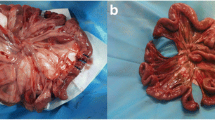Abstract
The purpose of these experiments was to evaluate two methods of bowel viability assessment in two distinct models of intestinal ischemia. Bowel viability was assessed in 32 dogs by means of three methods: (1) a probe that quantified the intestinal electromyographic (EMG) measurments in millivolts (mV), (2) Doppler ultrasonography, and (3) perfusion fluorometry, which quantified serosal blood flow in indexed dye fluorescence units (dfi). Ischemia was creased using one of two methods: (1) a chronic model in which the blood supply to 40 cm of ileum was ligated and viability assessed 24 hours later, or (2) an acute model in which the main superior mesenteric artery was occluded for 31/2 hours and then released. Viability parameters were assessed every 5 minutes for 30 minutes after release. After viability assessment was completed, the ischemic bowel was resected and anastomosed at the site where the EMG measurements approximated 50% of the values obtained in normal bowel. In the chronic group 3 of 20 dogs died of nerosis in contrast to none of 12 dogs in the acute reperfusion group. In the acute model EMG values steadily increased after reperfusion, stabilizing by 15 minutes after release. Mean EMG values at 15 through 30 minutes after release were significantly greater than the 5- and 10-minute postrelease and prerelease values, suggesting that the electromyogram is affected by reperfusion. Conversely, postrelease fluorometry measurements rapidly increased to levels that exceeded measurements obtained in normal bowel. There was a significant differencen in the number of audible, Doppler signals in the marginal artery of survivors of the acute vs. the chronic model. Fluorometry measurements in survivors of the acute model (99±9 dfi) were significantly greater than measurements in the chronic model (54±4 dfi,P≤0.004). Conversely, intermodel differences in the EMG measurements were not significant. These results show significant differences in the magnitude of ischemic damage induced by reperfusion vs. mesenteric ligation, which had a significant impact on the objective blood flow mesurements that were used to predict bowel viability. The results also suggest that intestinal reperfusion injury in dogs has a negligible impact on bowel survival.
Similar content being viewed by others
References
Tepperman BL. Measurement of gastrointestinal blood flow. Annu Rev Physiol 1982; 44:71–82.
Bulkley GB, Zuidema GD, Hamilton SR, et al. Intraoperative determination of small intestinal viability following ischemic injury. Ann Surg 1980; 193:628–637.
Wright CB, Hobson RW Jr. Prediction of intestinal viability using Doppler ultrasound techniques. Am J Surg 1975; 129:642–645.
Brolin RE, Semmlow JL, Mackenzie JW, et al. Quantitative myoelectric determination of bowel viability. J Surg Res 1986; 41:557–562.
Orland PJ, Cazi G, Semmlow JL, et al. Determination of small bowel viability using quantitative myoelectric and color analysis. J Surg Res 1993; 55:581–587.
Brolin RE, Orland PJ, Bibbo C, et al. Comparison of blood flow and myoelectric measurements in two chronic models of mesenteric ligation. Arch Surg 1995; 130:147–152.
Semmlow JL, Brolin RE. Instrumentation for quantitative assessment of intestinal viability. IEEE Trans Biomed Eng 1988; 35:888–892.
Cabot RM, Kohatsu S. The effects of ischemia on the electrical and contractile activities of the canine small intestine. Am J Surg 1978; 136:342–346.
Code CF, Szurszewski JH. The effect of duodenal and mid small bowel transection on the frequency gradient of the pacesetter potential in the canine small intestine. J Physiol (Lund) 1970; 207:287–299.
Parks DA, Granger DN. Contributions of ischemia and reperfusion to mucosal lesion formation. Am J Physiol 1986; 250:G749-G753.
Haglund U, Bulkley GB, Granger DN. On the physiology of intestinal ischemic injury. Acta Chir Scand 1987; 153:321–324.
Grogaard G, Parks DA, Granger DN, et al. Effects of ischemia and oxygen radicals on mucosal albumin clearance in intestine. Am J Physiol 1982; 242:6448–6454.
Parks DA, Grogaard B, Granger DN. Comparison of partial and complete arterial occlusion models for studying intestinal ischemia. Surgery 1982; 92:896–901.
Robinson RWL, Mirkovitch V. The recovery of function and microcirculation in small intestínal loops following ischemia. Gut 1972; 13:784–789.
Dalsing MC, Grosfeld JL, Shiffler MA, et al. Superoxide dismutase: A cellular protective enzyme in bowel ischemia. J Surg Res 1983; 34:589–596.
Caty MG, Guice KS, Oldham KT, et al. Evidence for tumor necrosis factor-induced pulmonary microvascular injury after intestinal ischemia-reperfusion injury. Ann Surg 1990; 212: 694–700.
Lelli JL, Pradhan S, Cobb LM. Prevention of postischemic injury in immature intestine by deferoxamine. J Surg Res 1993; 54:34–38.
Amano H, Bulkley GB, Gorey T, et al. The role of microvascular patency in the recovery of small intestine from ischemic injury. Surg Forum 1980; 31:157–159.
Boros M, Karacsony G, Kaszaki J, et al. Reperfusion mucosal damage after complete intestinal ischemia in the dog: The effects of antioxidant and phospholipase A2 inhibitor therapy. Surgery 1993; 113:184–191.
Boros M, Kaszaki J, Ordogh R, et al. Intramucosal pH changes following complete segmental small intestinal ischemia, as compared with the effects of superior mesenteric artery occlusion. Eur Surg Res 1994; 26:76–86.
Author information
Authors and Affiliations
Additional information
Supported by grant 91-6-052 from the American Heart Association, New Jersey Affiliate.
Rights and permissions
About this article
Cite this article
Brolin, R.E., Bibbo, C., Petschenik, A. et al. Comparison of ischemic and reperfusion injury in canine bowel viability assessment. J Gastrointest Surg 1, 511–516 (1997). https://doi.org/10.1016/S1091-255X(97)80066-2
Issue Date:
DOI: https://doi.org/10.1016/S1091-255X(97)80066-2




